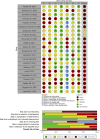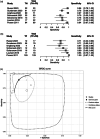Contribution of point-of-care ultrasound in the prehospital management of patients with non-trauma acute dyspnea: a systematic review and meta-analysis
- PMID: 39630617
- PMCID: PMC11855997
- DOI: 10.1097/MEJ.0000000000001205
Contribution of point-of-care ultrasound in the prehospital management of patients with non-trauma acute dyspnea: a systematic review and meta-analysis
Abstract
Acute dyspnea is a common symptom whose management is challenging in prehospital settings. Point-of-care ultrasound (POCUS) is increasingly accessible because of device miniaturization. To assess the contribution of POCUS in the prehospital management of patients with acute nontraumatic dyspnea, we performed a systematic review on nontrauma patients of any age managed in the prehospital setting for acute dyspnea and receiving a POCUS examination. We searched seven databases and gray literature for English-language studies published from January 1995 to November 2023. Two independent reviewers completed the study selection, data extraction, and risk of bias assessment. The primary outcome was the assessment of the contribution of POCUS to feasibility, diagnostic, therapeutic, prognosis, patient referral, and transport vector modification. Twenty-three studies were included. The risk of bias assessment identified 3 intermediate-risk, 18 serious-risk, and 2 critical-risk studies. Three studies reported moderate to excellent feasibility for lung POCUS, and three studies reported poor to mediocre feasibility for cardiac POCUS. The median duration of the POCUS examination was less than 5 minutes (six studies). POCUS improved diagnostic identification (seven studies). The diagnostic accuracy of POCUS was excellent for pneumothorax (sensitivity = 100%, specificity = 100%, two studies), very good for acute heart failure (sensitivity = 71-100%, specificity = 72-95%, eight studies), good for pneumonia (sensitivity = 88%, specificity = 59%, one study), and moderate for pleural effusion (sensitivity = 26-53%, specificity = 83-92%, two studies). Treatment was modified in 11 to 54% of the patients (seven studies). POCUS had no significant effect on patient prognosis (two studies). POCUS contributed to patient referrals and transport vectors in 51% (four studies) and 25% (three studies) of patients, respectively. The evidence supports the use of POCUS for managing acute nontraumatic dyspnea in the prehospital setting in terms of feasibility, overall diagnostic contribution, and, particularly, lung ultrasound for acute heart failure diagnosis. Moreover, POCUS seems to have a therapeutic contribution. There is not enough evidence supporting the use of POCUS for pneumonia, pleural effusion, pneumothorax, chronic obstructive pulmonary disease, or asthma exacerbation diagnosis, nor does it support prognostic, patient referral, and transport vector contribution. A high level of evidence is lacking and needed.
Copyright © 2024 The Author(s). Published by Wolters Kluwer Health, Inc.
Conflict of interest statement
There are no conflicts of interest.
Figures



References
-
- American College of Emergency Physicians. Ultrasound guidelines: emergency, point-of-care, and clinical ultrasound guidelines in medicine. Ann Emerg Med. 2023; 82:e115–e155. - PubMed
-
- Ovesen SH, Clausen AH, Kirkegaard H, Løfgren B, Aagaard R, Skaarup SH, et al. . Point-of-care lung ultrasound in emergency medicine. Chest. 2024; 166:544–560. - PubMed
Publication types
MeSH terms
LinkOut - more resources
Full Text Sources
Medical

